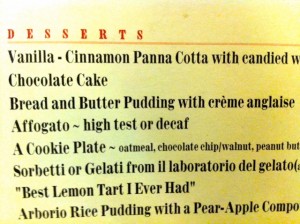 Have you ever been ready to order your usual meal when something on the menu seems to reach out and grab you? Those long tentacles aren’t a fluke, but a product of creative phrasing and mouth-watering words. Bacon and eggs can turn into a “fluffy omelette made with farm fresh eggs, leafy spinach, and crisp applewood smoked bacon.”
Have you ever been ready to order your usual meal when something on the menu seems to reach out and grab you? Those long tentacles aren’t a fluke, but a product of creative phrasing and mouth-watering words. Bacon and eggs can turn into a “fluffy omelette made with farm fresh eggs, leafy spinach, and crisp applewood smoked bacon.”
Putting a dish with a really mouth-watering description — like the fluffy omelette — next to something that’s described in plain jane language — like bacon and eggs with hash browns – can make the omelette sound all the more appealing and a very attractive menu choice.
Menu Language
Menu language is an art unto itself. Descriptive menu labels, especially the ones that yank your nostalgia strings or offer clear explanations, might entice you to order something exotic or strange. For instance, you might take a leap and order branzino if you know it’s European sea bass or chanterelle if you know it’s a mushroom.
Artful adjectives, like “handcrafted, slow-cooked, or old-time flavor” can sway your choice and leave you more satisfied at the end of the meal. So can “crispy” rather than “fried” or “poached” instead of “boiled.”
For example, how could you not try the “Best Lemon Tart I Ever Had,” the next to the last selection shown above? The description grabs you and makes you feel as though you’d be a fool to pass it up. Once you taste it, If it proves to be as good as its description, it’s almost guaranteed that a customer will order it again and again – and that the restaurant make a lot of money from selling their signature lemon tart.
Tip: Descriptive menu labels, especially those that evoke nostalgia, yank your chain – and can boost sales by as much as 27%.
Familiar Items Vs. Special Or Unique
As a general rule, restaurants leave familiar items alone. Roast beef is roast beef and a fancy description might be annoying. But elaborating on something special or unusual — like locally grown arugula with fresh garden herbs — makes a dish more intriguing and you won’t think you’re being ripped off for a bed of lettuce.
Restaurants can steer you toward high profit margin choices by making some descriptions more appealing than others. There’s a continuum of appeal — having everything sound equally delicious isn’t much different than having everything sound equally bland.
Tip: A menu can make you feel like you’d be crazy to pass up an item with a mouth-watering description by toning down the descriptions of competing choices. The competition still might be good — it just doesn’t sound as great as the dish the restaurant wants you to order.
Do you eat out? This is the sixth article in a series of consecutive posts about decoding restaurant menus. Keep checking back for more information that might help you with your restaurant choices.
Please share if you know anyone who wants to Eat Out and Eat Well!